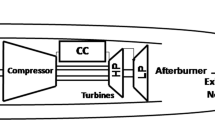Abstract
The current paper presents an internal cooling redesign for a high-pressure turbine nozzle guide vane. The primary design goal is to achieve a longer creep life at constant cooling consumption, referred to as maintenance concept. The same design could be used in performance concept, permitting coolant flow reduction without affecting durability. To minimize manufacturing costs, the same wax tool (external geometry) as the original one has been used, and the only change is the introduction of new core geometry. The ability to retrofit existing units is another important constraint for this development. Consequently, the new design has a similar cooling structure with the same coolant feed and pressure side cut-back ejection as the original vane. Design steps, as well as necessary tools, are discussed in detail. A simplified approach is presented to roughly estimate thermal-induced stress for complex geometries based on the temperature linearization concept. The method is shown to be suitable for the preliminary design optimization level while significantly reducing design cycle time. For the detailed design, comprehensive CFD and FEM simulations are performed to evaluate temperature, stress, and cumulative creep damage distributions. Results indicate that the new design has considerably alleviated airfoil max metal temperature as well as cross-sectional temperature gradients. For the maintenance concept, a 65% longer operating life is estimated, and for the performance concept, more than 20% of coolant flow will be saved.
Access this article
We’re sorry, something doesn't seem to be working properly.
Please try refreshing the page. If that doesn't work, please contact support so we can address the problem.















Similar content being viewed by others
Abbreviations
- Dh :
-
Hydraulic Diameter (m)
- e/P:
-
Height to pith ratio (–)
- E:
-
Elastic modulus (N/\({\mathrm{m}}^{2}\))
- k:
-
Thermal conductivity (w/mK)
- LMP:
-
Larson Miller Parameter (–)
- Pr:
-
Total to static pressure ratio (–)
- \({\mathrm{t}}_{r}\) :
-
Time to Rupture (s)
- \(\varepsilon\) :
-
Cooling effectiveness (–)
- \(\eta\) :
-
Cooling efficiency (–)
- \(\alpha\) :
-
Coefficient of Thermal Expansion
- 0:
-
Reference or total value
- gs:
-
Value at metal gas side
- cs:
-
Value at metal cool side
References
Abo El Ata MM, Finnie I (1972) A Study of Creep Damage Rules. ASME J Basic Eng 94(3):533–541
Alizadeh M, Izadi A, Fathi A (2013) Sensitivity analysis on turbine blade temperature distribution using conjugate heat transfer simulation. ASME J Turbomach, vol 136, TURBO-12–1045
Bons JP (2010) A review of surface roughness effects in gas turbines. ASME J Turbomach 132(2):021004
Bunker RS (2017) Evolution of turbine cooling, ASME TURBOEXPO, GT2017–63205
Farhanieh A, Mau C, Annerfeldt M, Nadali H, Karlsson M (2016) Unsteady effects in the heat load predictions for a two-stage compressor turbine, ASME TURBOEXPO, GT2016-57742
Farhanieh A (2016) Investigation on methods to improve heat load prediction of the SGT-600 gas turbine. Master Thesis, Linkoping University., LIU-IEI-TEK-A–15/02403–SE
Ginter T (2008) Uprate Options for the MS9001, Atlanta, GA: GE Energy, GER-3928C
Han J-C (2013) Gas turbine heat transfer and cooling technology. Taylor & Francis, Milton Park
Meitner PL (1990) Computer code for predicting coolant flow and heat transfer in turbomachinery, Cleveland, Ohio, NASA-298
Moustapha H, Zelesky MF, Baines NC (2003) Axial and radial turbines. Concepts NREC, New York
Shukin S, Annerfeldt M, Bjorkman M (2008) Siemens SGT-800 industrial gas turbine enhanced to 47MW. Design modifications and operation experience,” ASME TURBOEXPO, GT2008–50087
Stewart CM (2013) A hybrid constitutive model for creep, fatigue, and creep-fatigue. Ph.D. Thesis, University of Central Florida
Town J, Thole K, Shih T (2017) State-of-the-art cooling technology for a turbine rotor blade, ASME TURBOEXPO, GT2017–64728
Wang L, Bahador M, Bruneflod S, Annerfeldt M, Björkman M, Hultmark I (2013) Siemens SGT-800 industrial gas turbine enhanced to 50 MW: Turbine design modifications, validation and operation experience, ASME TURBOEXPO, GT2013–95462
Author information
Authors and Affiliations
Corresponding author
Rights and permissions
About this article
Cite this article
Yavari, H., Alizadeh, M., Akheratdoost, H. et al. Thermo-mechanical Redesign of a High-Pressure Turbine Nozzle Guide Vane. Iran J Sci Technol Trans Mech Eng 47, 81–90 (2023). https://doi.org/10.1007/s40997-022-00522-z
Received:
Accepted:
Published:
Issue Date:
DOI: https://doi.org/10.1007/s40997-022-00522-z




